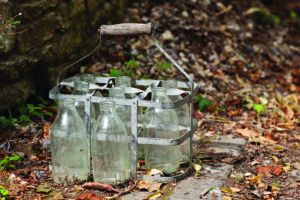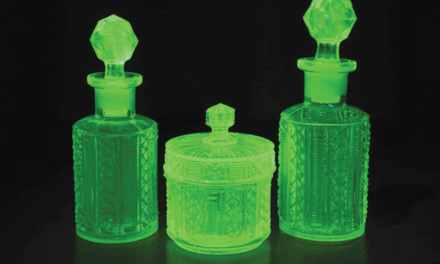(Editor’s note: DeeDee Wood is the owner of Black Cat Curiosities, an online antiques research and sales venue.)
We generally drink milk from a heavy paperboard or polyethylene (plastic) carton from the dairy case from our local grocery.
Many of us drink the white liquid from this carton or jug, never giving a second thought to the history of the delivery of milk, and more specifically the glass milk bottle, which, in some forms, is a highly collectible Americana antique in the market.
During the late 1800s, the Industrial Revolution provided dairy farmers the ability to distribute their products to a larger, wider range of consumers, with the use of machinery and more mass delivery systems.
A glass bottle, which made milk delivery more sanitary, came into being in the United States, and it changed the way milk could be consumed by the general household.
Before the invention of the glass milk bottle, deliveries of milk, in the mid-1800s, were dipped out of a ladle from the “milkman” truck supply, from the dairy wagons.
The milk was deposited into whatever the consumer had to collect it, such as a jug or homemade collection device of some type. 
A druggist, Dr. Hervey Thatcher from Potsdam, N.Y., observed debris going into the ladled milk and developed first, a patented pail to catch the delivery, and later, the glass milk bottle, called the “Milk Protector” that was the first glass milk bottle, created in 1885.
Those early milk bottles were hand-blown, but later, were manufactured using molds.
The sealing of these milk bottle tops, and the designs that were ever-changing, showed the ingenuity and problem-solving resolve of these early inventors.
The Lewis Whiteman patent for a glass lid with tin clips was created in the late 1800s, originating out of Cumberland, Maryland, from the Warren Glass Works Company.
Even before patents were applied for officially in the dairy industry, the transport and delivery of milk was becoming important and lucrative, so companies like the Tuthill Milk Company and “Mackworth Creamery Crock” were first attempts to standardize the milk industry with containers that could be used over and over for delivery, with logos and branding.
In 1889, Dr. Thatcher and a businessman named Harvey Barnhart developed something called a “Common Sense Milk Bottle” and the patent was obtained. Basically, it had a ledge around the opening of the bottle that would hold a “cap,” made out of a cardboard disc.
This design became industry standard by the 1900s, and there was even a special tool, called a pick, that would aid in the removal of the cap.
Wires, plugs and glass stoppers would also be invented to enclose milk during the turn of the century by various companies.
Early milk bottle companies would emboss their logos right into the glass manufacturing process, so a collector can tell earlier bottles from the logos ‘embedded” into the glass, which was inserted during the manufacturing process, using something called a slug plate.
As we fast forward into the 1930s, companies made labels that were affixed directly onto the glass, often in monochrome or duo-colored labels, such as red and white.
Affixing these labels onto the bottles was called ACL, or applied color labels.
Milk was delivered daily in those early days of milk bottle creation, because generally the standard household had no proper refrigeration. For many years, milk bottles often contained a “cream spoon” as well, that would help mix the cream layer, that rose to the top of the jar. A process called homogenization of milk, or the heating and mixing of milk to melt the fat globules into the milk body, precluded the necessity to have to mix the cream any longer.
As well, the process of pasteurization of milk, or the heating of milk, beginning in the late 1800s, helped remove microbes out of the milk that could be dangerous to consume.
The storage and consumption of milk became less and less of a problem due to the processes of pasteurization and homogenized milk in the industry from the late 1800s onward.
The milk bottle took on many shapes through the years, to the initial round body and wider top to hold the cream, to a more tapered top to hold various styles of caps or closures, to square bottles that were easier to fit into carriers and storage in the home, to the demise of the heavy bottle in the 1950s and early 1960s, in favor of more lightweight products, such as early plastic containers and paperboard versions, earlier styles and designs of what we use today.
Caps, spoons, styles, shapes, embossed logos, label indications and condition all dictate the milk bottle collector’s decision to buy a glass milk bottle today.
Unlike other antiques, the milk bottle gives the antique collector many clues to determine worth, history and area of origin.
Necessity, in the milk bottle industry, truly was the mother of invention.




